
Firefly Metals Ltd. – Green Bay Copper-Gold Project, Canada
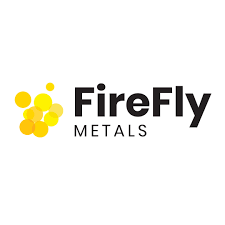
FireFly’s first drilling in new area hits high-grade VMS mineralisation
The exceptional results highlight potential for a repeat of the Green Bay Project’s high grade large scale flagship Ming Mine
KEY POINTS
- FireFly’s maiden drilling program at the historical Rambler Main Mine within Green Bay has returned high-grade gold-copper-zinc intersections
- Initial drilling targeted down-plunge extensions, with the first two drill holes returning exceptional intersections of:
- 10.0m @ 6.4% CuEq[1] (5.7g/t Au, 1.3% Cu, 1.7% Zn & 20.9g/t Ag) in hole FFR25-001 (~ true thickness)
- 12.9m @ 4.3% CuEq (4.2g/t Au ,0.5% Cu, 1.5% Zn & 10.9g/t Ag) in hole FFR25-002 (~ true thickness)
- These step-out holes have extended the known mineralisation more than 200m beyond the limit of historical mining and it remains open down plunge
- The results show Rambler Main shares many ‘look-alike’ features with the rich Ming Mine ~2km away, including the nature of the down-plunge extension from historical mining and the fact that the mineralisation remains open
- This mineralisation at Rambler Main is also part of the same camp-scale Volcanogenic Massive Sulphide (VMS) system that formed the Ming deposit with the mineralisation located on the same geological contact
- Given the strength of these results and the key similarities with Ming, there is clearly potential for Rambler Main to be an important source of Mineral Resource growth at Green Bay
- A similar surface drilling program has also been conducted at the nearby historical East Mine, with results expected soon
- The surface drill rig is now back at Rambler Main testing for further depth extensions of the gold-copper-zinc mineralisation reported in this announcement
- These programs are aimed at growing the overall Mineral Resource by unlocking the camp-scale potential at Green Bay
- Rambler Main was mined to 200m below surface between 1964 and 1967, with historical records indicating production of 440kt @ 1.3% copper, 4.7g/t gold and 2.2% zinc
- The Green Bay Mineral Resource Estimate stands at 24.4Mt at 1.9% CuEq Measured & Indicated Resource and 34.5Mt at 2.0% CuEq Inferred Resource; see ASX announcement dated 29 October 2024
- The Company remains well funded for its accelerated growth strategy with ~A$68.5M in cash, receivables and liquid investments at 31 March 2025
| ____________________________ |
| 1 Metal equivalent for drill results reported in this announcement have been calculated at a copper price of US$8,750/t, gold price of US$2,500/oz, silver price of US$25/oz and zinc price of US$2,500/t. Metallurgical recoveries have been set at 95% for copper, 85% for precious metals and 50% for zinc. Copper equivalent was calculated based on the formula CuEq(%) = Cu(%) + (Au(g/t) x 0.82190) + (Ag(g/t) x 0.00822) + (Zn(%) x 0.15038). In the opinion of the Company, all elements included in the metal equivalent calculation have a reasonable potential to be sold and recovered based on current market conditions, metallurgical test work, and historical performance achieved at the Green Bay project whilst in operation. |
FireFly Managing Director Steve Parsons said: “To generate such outstanding results from our first two holes in this area shows we could have another Ming Mine on our hands.
“It is already clear that Rambler Main shares many key similarities with Ming, including being part of the same VMS system, and the mineralisation remains open down plunge.
“The results also support our view of the camp-scale potential at Green Bay and therefore the scope to keep growing the Mineral Resource through resource extensions and discoveries.”
FireFly Metals Ltd (ASX: FFM, TSX: FFM) is pleased to announce high-grade gold and copper mineralisation from its surface drill program at the Green Bay Copper-Gold Project.
Surface exploration initially focused on the Rambler Main Mine, which is just one of several historical VMS deposits mined at Green Bay in the 1960s and 1970s. Located less then 2km from the flagship Ming Mine, the Rambler Main deposit was mined to only 200m below surface between 1964 and 1967 and remained open. Published estimates of historical production at Rambler Main Mine total 440kt @ 1.3% copper, 4.7g/t gold and 2.2% zinc.
The maiden FireFly surface drilling successfully targeted extensions of mineralisation beyond the extent of historical mining activities at Rambler Main mine. Thick intersections of Volcanogenic Massive Sulphide style mineralisation were encountered up to 200m down plunge of historic workings, and the mineralisation remains open. Results from the first two holes returned polymetallic intersections of:
- 10.0m @ 5.7g/t gold, 1.3 copper, 1.7% zinc and 20.9g/t silver (6.4% CuEq) (~ true thickness)
- 12.9m @ 4.2g/t gold, 0.5% copper, 1.5% zinc and 10.9g/t silver (4.3% CuEq) (~ true thickness)
Rambler Main Mine mineralisation is part of the same camp-scale geological system that formed the Ming deposit, with both zones of VMS mineralisation being located at the rhyolite-basalt contact. The mineralisation at Rambler Main Mine differs from Ming in that it is gold dominated, likely reflecting variations in temperature and fluid composition at the time of formation.
Limited down plunge drilling has been undertaken at Rambler Main Mine. The VMS lodes at Rambler Main exhibit the same moderate north-east dipping geometry as Ming. This style of mineralisation at Ming has a confirmed strike extent exceeding 2.5km. Drilling is currently underway to further test the strike extent at Rambler Main Mine, which remains open.
The results from Rambler Main Mine demonstrate the potential for future shallow Mineral Resource additions to complement the significant growth expected from the Ming Mine as the underground drilling continues. The current Green Bay Mineral Resource Estimate stands at 24.4Mt @ 1.9% CuEq in the Measured and Indicated Resource categories and 34.5Mt @ 2.0% CuEq in the Inferred Resource category. The value of any Mineral Resource additions close to the Ming Mine is enhanced by the potential to share infrastructure, with economic studies into the upscaled restart of operations in progress and expected for completion later in 2025.
The surface exploration campaign is in full swing with assays pending for drilling completed recently at the nearby historical East Mine. The drill rig has now returned to the Rambler Main mine, with deeper step-out drilling underway to test for further extensions. Ground geophysical crews continue to further refine anomalies identified in the airborne VTEM survey previously completed by FireFly. Field season has commenced with geologists conducting additional mapping and surface sampling on the Company’s extensive 311km2 of highly prospective exploration claims.
FireFly remains committed to accelerating its growth strategy. This comprises a combination of Mineral Resource growth, upgrading the current Mineral Resource and making new copper-gold discoveries. A total of six drill rigs are currently operating at Green Bay (five underground and one on surface). An additional underground rig is scheduled to arrive in the coming weeks. Mineral Resource updates and preliminary economic mining studies are expected to be delivered later in 2025.
The Company remains well funded to execute its growth strategy, with ~A$68.5M in cash, receivables and liquid investments at 31 March 2025.
About the Drill Results
The drill results in this announcement are the first of the surface exploration assays returned for the 2025 campaign. The Company holds 311km2 of highly prospective exploration claims that encompass eight previously producing mining operations and numerous regional drill-ready copper and gold targets.
Following comprehensive data compilation and a number of geophysical VTEM and gravity surveys, initial drilling was designed to test for extensions of mineralisation at the historical Rambler Main and East mines. These deposits are part of the same geological system that formed the Ming Mine, which has current Mineral Resource of 22Mt @ 1.8% CuEq in the higher confidence Measured and Indicated Resource category in addition to 28Mt @ 2.0% CuEq of Inferred Mineral Resources.
Geological Description of the Rambler District Deposits
There are two distinct styles of mineralisation present in the greater Rambler district, consisting of a series of upper copper-gold rich Volcanogenic Massive Sulphide lenses underlain in places by a broad copper stringer zone, known as the Footwall Zone.
The structurally influenced and modified VMS deposits are characterised by extensive copper and gold rich channels of massive sulphides deposited on the seafloor along extensive basin structures. The upper massive sulphides are consistently present at the contact between felsic volcanics (rhyolite) and mafic volcanics (basalt). As the fluids migrated along deep-tapping feeder structures toward the seafloor, copper dominant stringers were deposited as the footwall rhyolite was altered. This is expressed as footwall-style mineralisation at the Ming Mine. The sub-seafloor rocks immediately beneath the massive sulphides are characteristically silica-sericite altered and may contain disseminated sulphides. Post-depositional structural movement resulted in a pervasive moderately north dipping foliation. Primary sulphides were remobilised and often exhibit the same direction as the regional foliation.
Rambler Main Mine
The Rambler Main deposit consists of a seafloor massive sulphide horizon underlain by intensely silica-sericite altered footwall rocks. The alteration zone beneath the massive sulphide contains pervasive sulphides (pyrite, sphalerite and chalcopyrite). It is the silica-sericite altered schists that commonly contains the highest concentrations of gold.
The Rambler Main deposit was mined to a depth of approximately 200m below surface between 1964 and 1967. Pilote et al (2017)[2] reported historical production at Rambler Main Mine of 440kt of ore mined at a grade of 1.3% copper, 4.7g/t gold, 2.2% zinc and 26.4g/t silver.
The mine was accessed via a decommissioned shaft with sub-levels driven in the footwall towards the ore horizon.
| ___________________________ |
| 2 Source: Pilote, J et al; Volcanic and Structural Reconstruction of the Deformed and Metamorphosed Ming Volcanogenic Massive Sulphide Deposit, Canada: Implications for Ore Zone Geometry and Metal Distribution. Economic Geology 2017; 112(6) 1305-1332 |
Drill Results
Two drill holes were planned to test for continuity of the sulphide mineralisation down plunge of where the mining ceased in 1967. Drilling successfully demonstrated that the mineralisation continues for 200m beyond historical mining.
FFR25-001 intersected a semi-massive sulphide horizon above an intensely silica-sericite-sulphide altered gold-bearing schist (Figure 4). The intersection graded:
- 10.0m @ 5.7g/t gold, 1.3% copper, 1.7% zinc and 20.9g/t silver
FFR25-002 intersected a semi-massive sulphide horizon above an intensely silica-sericite-sulphide altered gold-bearing schist (Figure 5). The intersection graded:
- 12.9m @ 4.2g/t gold, 0.5% copper, 1.5% zinc and 10.9g/t silver
The location of drill positions and holes reported in this announcement are presented in Figure 1 and Figure 2. Significant assay results are presented in Appendix B of this announcement.
Forward Work Plan
Near-term drilling activities at the Green Bay Copper-Gold Project will continue to focus on three key areas:
- Mineral Resource extension: Test the down-plunge continuation of both the high-grade copper-gold VMS zones and the broad footwall copper stringer zone: ~35,000m of drilling
- Infill drilling: Create value through the conversion of Inferred areas of the Mineral Resource to Indicated for inclusion in future mining studies: ~35,000m of drilling; and
- Discovery drilling: Exploration for new zones of mineralisation from both surface and underground. The aim is to demonstrate the camp-scale potential of the district by developing a pipeline of future Mineral Resource growth projects to complement the Ming Mine: ~10,000m of drilling
The drilling reported in this announcement demonstrates potential for additional discoveries and Mineral Resource additions outside of the Ming deposit. The Company has built a portfolio of high-quality exploration claims that now cover an area of 311km2.
FireFly has undertaken extensive generative work on the Green Bay project and this remains ongoing as new data is acquired. Initial work focused on compilation and digitalisation of historical data. Multiple geophysical surveys have been completed, with the largest being a lease wide airborne VTEM survey. Numerous anomalies were identified by the airborne work, and close spaced ground EM surveys are continuing to further refine targets. The field season has commenced, and the geological team has commenced mapping and field sampling activities.
Surface exploration drilling will systematically test the multitude of regional targets throughout 2025, initially focused on the greater Rambler VMS district within 5km of the Ming Mine.
Rambler Main Mine (this announcement) and East Mine extensions (assays pending) are the first two targets to be tested. The drill rig will then test the Hillbog-Rambler #1 anomaly identified from historical records. The exploration focus will then shift to the southern Green Bay project areas, where rock chip samples of up to 27% copper have been recorded (see ASX announcement dated 22 August 2024).
FireFly will continue with its low-cost rapid Mineral Resource growth strategy, with the underground exploration drill drive continuing to be extended to allow effective drill testing down plunge as well as discovery drilling utilising Down Hole Electromagnetics (DHEM) for new parallel and repeat lodes at the Ming deposit. DHEM has identified an anomalous conductor that extends for 700m beyond the current drilling (see ASX announcement dated 7 May 2025).
Infill drilling continues to demonstrate continuous and consistent high-grade copper and gold mineralisation at the Ming Mine. The infill drilling will contribute to upgrading the Inferred Resource (34.5Mt @ 2.0% CuEq) to the higher quality M&I Resource category, which currently stands at 24.4Mt @ 1.9% CuEq (see ASX announcement dated 29 October 2024). The higher confidence M&I Resource will form the basis of future economic studies.
Due to the exceptional results achieved to date, the Company has decided to accelerate the drill program by contracting a sixth underground drill, which is currently en route to site.
Engineering studies continue to evaluate various scenarios for an up-scaled restart to operations, which will incorporate the expected 2025 Mineral Resource Estimate updates once finalised. With the huge success of the drilling programs to date, the Company does not want to limit the size of any future potential upscaled mining operation until it has completed the next phase of growth drilling.
The Company remains well funded to deliver its accelerated growth strategy with ~A$68.5M in cash, receivables and liquid investments at the end of March 2025.
ABOUT FIREFLY METALS
FireFly Metals Ltd is an emerging copper-gold company focused on advancing the high-grade Green Bay Copper-Gold Project in Newfoundland, Canada. The Green Bay Copper-Gold Project currently hosts a Mineral Resource prepared in accordance with the 2012 Edition of the Australasian Code for Reporting of Exploration Results, Mineral Resources and Ore Reserves (JORC Code 2012) and Canadian National Instrument 43-101 – Standards of Disclosure for Mineral Projects (NI 43-101) of 24.4Mt of Measured and Indicated Resources at 1.9% for 460Kt CuEq and 34.5Mt of Inferred Resources at 2% for 690Kt CuEq. The Company has a clear strategy to rapidly grow the copper-gold Mineral Resource to demonstrate a globally significant copper-gold asset. FireFly has commenced a 130,000m diamond drilling program.
FireFly holds a 70% interest in the high-grade Pickle Crow Gold Project in Ontario. The current Inferred Resource stands at 11.9Mt at 7.2g/t for 2.8Moz gold, with exceptional discovery potential on the 500km2 tenement holding.
The Company also holds a 90% interest in the Limestone Well Vanadium-Titanium Project in Western Australia.
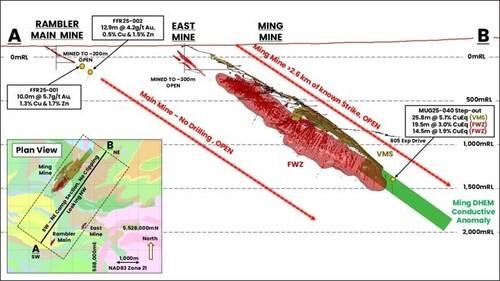
Figure 1: Regional long section highlighting the shallow depth of mining and drill testing of the Rambler Main and East Mines relative to the adjacent 50mt Ming Mine. The drilled strike of the Ming Mine now exceeds 2.6km while the Rambler Main is only 300m and is completely open down plunge. All regional deposits remain open. See ASX announcement dated 7 May 2025 for details of Ming Mine step-out drilling and conductive anomaly. (CNW Group/FireFly Metals Ltd.)
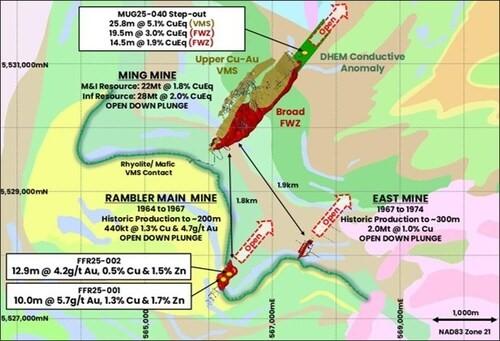
Figure 2: Plan view showing location of the FireFly drill results from Rambler Main Mine relative to the Ming Mine and East Mine. All three deposits dip moderately towards the north-east and with VMS mineralisation occurring at the folded contact between the rhyolite (yellow) and the mafic units (green). The latest Ming Mine extensional drill results and DHEM geophysical anomaly is also shown (see ASX announcement dated 7 May 2025 for further details). (CNW Group/FireFly Metals Ltd.)
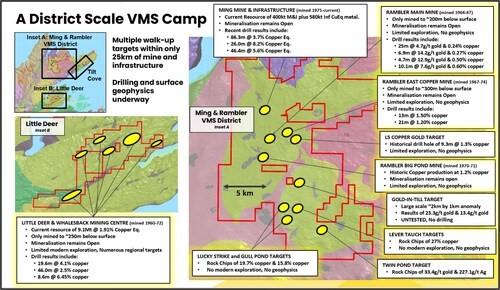
Figure 3: Camp-scale regional landholding held 100% by FireFly. Multiple high priority VMS targets will be systematically drill tested throughout 2025. (CNW Group/FireFly Metals Ltd.)

Figure 4: Core photograph of FFR25-001 showing the gold-bearing zone ~100m down plunge of historical workings at the Rambler Main Mine. Gold occurs within the alteration zone beneath the semi-massive sulphide horizon. (CNW Group/FireFly Metals Ltd.)
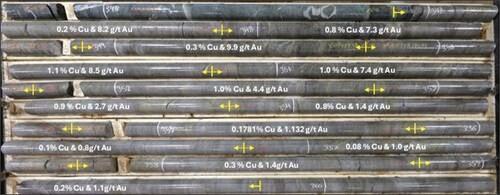
Figure 5: Core photograph of FFR25-002 showing the gold-bearing zone ~200m down plunge of historical workings at the Rambler Main Mine. Gold occurs within the intense silica-sericite altered zone in the footwall of the semi-massive sulphide horizon. (CNW Group/FireFly Metals Ltd.)
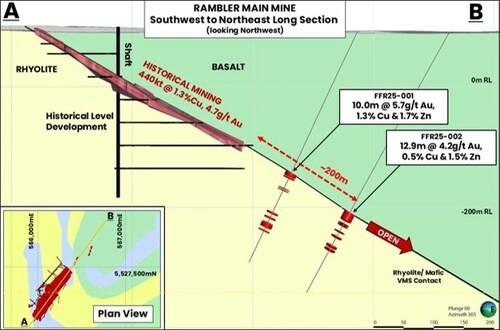
Figure 6: Long section through the historical Rambler Main Mine workings showing high grade VMS mineralisation that remains OPEN. SW to NE section looking NW. Mineralisation is located at the contact between the footwall rhyolite (yellow) and hanging wall basalts (green) (CNW Group/FireFly Metals Ltd.)

Figure 7: Key 2024-2025 milestones for the Green Bay Copper-Gold Project. 1. Please note that timelines are indicative and may be subject to change. (CNW Group/FireFly Metals Ltd.)
MORE or "UNCATEGORIZED"
Kuya Silver Confirms High-Grade Silver-Gold Vein Mineralization at Umm-Hadid with Initial Drill Results up to 1483.9 g/t AgEq over 2 Metres
Kuya Silver Corporation (CSE: KUYA) (OTCQB: KUYAF) (FSE: 6MR1) is... READ MORE
First Phosphate Closes Final Tranche of Oversubscribed Private Placement
First Phosphate Corp. (CSE: PHOS) (OTCQX: FRSPF) (FSE: KD0) is... READ MORE
GFG Receives Final Payment from the Sale of its Rattlesnake Hills Gold Project
GFG Resources Inc. (TSX-V: GFG) (OTCQB: GFGSF) announces that i... READ MORE
Goliath Receives $1,730,882 Through Warrant Exercises, Inclusive Of Crescat Capital A Longtime Strategic And Cornerstone Shareholder
Goliath Resources Limited (TSX-V: GOT) (OTCQB: GOTRF) (FSE: B4IF)... READ MORE
Robex Pours First Gold at Kiniéro on Schedule and Budget
Highlights: Gold bar weighing 2.64 kilograms (85 oz) poured in th... READ MORE












